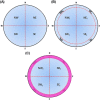Morris water maze: a versatile and pertinent tool for assessing spatial learning and memory
- PMID: 35314563
- PMCID: PMC9388345
- DOI: 10.1538/expanim.21-0120
Morris water maze: a versatile and pertinent tool for assessing spatial learning and memory
Abstract
Since its development about 40 years ago (1981-2021), Morris water maze has turned into a very popular tool for assessing spatial learning and memory. Its many advantages have ensured its pertinence to date. These include its effectiveness in evaluating hippocampal-dependent learning and memory, exemption from motivational differences across diverse experimental manipulations, reliability in various cross-species studies, and adaptability to many experimental conditions with various test protocols. Nonetheless, throughout its establishment, several experimental and analysis loopholes have galvanized researchers to assess ways in which it could be improved and adapted to fill this gap. Therefore, in this review, we briefly summarize these developments since the early years of its establishment through to the most recent advancements in computerized analysis, offering more comprehensive analysis paradigms. In addition, we discuss the adaptability of the Morris water maze across different test versions and analysis paradigms, providing suggestions with regard to the best paradigms for particular experimental conditions. Hence, the proper selection of the experimental protocols, analysis paradigms, and consideration of the assay's limitations should be carefully considered. Given that appropriate measures are taken, with various adaptations made, the Morris water maze will likely remain a relevant tool to assess the mechanisms of spatial learning and memory.
Keywords: Morris water maze; hippocampal-dependent learning and memory; spatial learning and memory.
Figures





Similar articles
-
Using the Morris water maze to assess spatial learning and memory in weanling mice.PLoS One. 2015 Apr 17;10(4):e0124521. doi: 10.1371/journal.pone.0124521. eCollection 2015. PLoS One. 2015. PMID: 25886563 Free PMC article.
-
Refinement of the Barnes and Morris water maze protocols improves characterization of spatial cognitive deficits in the lithium-pilocarpine rat model of epilepsy.Epilepsy Behav. 2023 Oct;147:109391. doi: 10.1016/j.yebeh.2023.109391. Epub 2023 Aug 22. Epilepsy Behav. 2023. PMID: 37619464
-
Search strategy selection in the Morris water maze indicates allocentric map formation during learning that underpins spatial memory formation.Neurobiol Learn Mem. 2017 Mar;139:37-49. doi: 10.1016/j.nlm.2016.12.007. Epub 2016 Dec 15. Neurobiol Learn Mem. 2017. PMID: 27988312
-
Using the spatial learning index to evaluate performance on the water maze.Behav Neurosci. 2015 Aug;129(4):533-9. doi: 10.1037/bne0000078. Behav Neurosci. 2015. PMID: 26214218 Free PMC article. Review.
-
Value of water mazes for assessing spatial and egocentric learning and memory in rodent basic research and regulatory studies.Neurotoxicol Teratol. 2014 Sep-Oct;45:75-90. doi: 10.1016/j.ntt.2014.07.003. Epub 2014 Aug 10. Neurotoxicol Teratol. 2014. PMID: 25116937 Review.
Cited by
-
Fangchinoline alleviates cognitive impairments through enhancing autophagy and mitigating oxidative stress in Alzheimer's disease models.Front Cell Dev Biol. 2023 Dec 11;11:1288506. doi: 10.3389/fcell.2023.1288506. eCollection 2023. Front Cell Dev Biol. 2023. PMID: 38146492 Free PMC article.
-
Hyperexcitation of the glutamatergic neurons in lateral hypothalamus induced by chronic pain contributes to depression-like behavior and learning and memory impairment in male mice.Neurobiol Stress. 2024 Jun 1;31:100654. doi: 10.1016/j.ynstr.2024.100654. eCollection 2024 Jul. Neurobiol Stress. 2024. PMID: 38948390 Free PMC article.
-
The study of therapeutic efficacy and mechanisms of Schisandra chinensis and Evodia rutaecarpa combined treatment in a rat model of Alzheimer's disease.Heliyon. 2023 Nov 7;9(11):e21942. doi: 10.1016/j.heliyon.2023.e21942. eCollection 2023 Nov. Heliyon. 2023. PMID: 38034776 Free PMC article.
-
Antibiotic-induced gut dysbiosis and cognitive, emotional, and behavioral changes in rodents: a systematic review and meta-analysis.Front Neurosci. 2023 Sep 1;17:1237177. doi: 10.3389/fnins.2023.1237177. eCollection 2023. Front Neurosci. 2023. PMID: 37719161 Free PMC article. Review.
-
MDPV (3,4-methylenedioxypyrovalerone) administered to mice during development of the central nervous system produces persistent learning and memory impairments.Pharmacol Rep. 2024 Jun;76(3):519-534. doi: 10.1007/s43440-024-00599-0. Epub 2024 May 9. Pharmacol Rep. 2024. PMID: 38722542 Free PMC article.
References
-
- Spiers HJ. Hippocampal Formation. 2nd edn, Encyclopedia of Human Behavior: Second Edition. 2nd edn. Elsevier Inc. 2012.
Publication types
MeSH terms
LinkOut - more resources
Full Text Sources
Medical
Miscellaneous

